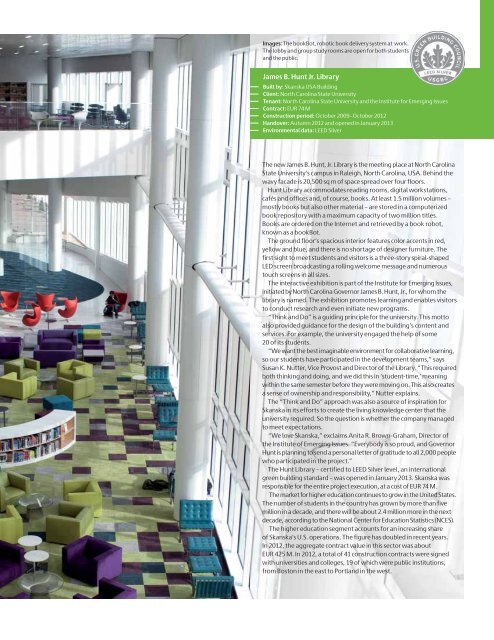Review of 2012 â EUR - Skanska
Review of 2012 â EUR - Skanska
Review of 2012 â EUR - Skanska
Create successful ePaper yourself
Turn your PDF publications into a flip-book with our unique Google optimized e-Paper software.
Images: The bookBot, robotic book delivery system at work.The lobby and group study rooms are open for both studentsand the public.James B. Hunt Jr. LibraryBuilt by: <strong>Skanska</strong> USA BuildingClient: North Carolina State UniversityTenant: North Carolina State University and the Institute for Emerging IssuesContract: <strong>EUR</strong> 74 MConstruction period: October 2009–October <strong>2012</strong>Handover: Autumn <strong>2012</strong> and opened in January 2013Environmental data: LEED SilverThe new James B. Hunt, Jr. Library is the meeting place at North CarolinaState University’s campus in Raleigh, North Carolina, USA. Behind thewavy facade is 20,500 sq m <strong>of</strong> space spread over four floors.Hunt Library accommodates reading rooms, digital workstations,cafés and <strong>of</strong>fices and, <strong>of</strong> course, books. At least 1.5 million volumes –mostly books but also other material – are stored in a computerizedbook repository with a maximum capacity <strong>of</strong> two million titles.Books are ordered on the Internet and retrieved by a book robot,known as a bookBot.The ground floor’s spacious interior features color accents in red,yellow and blue, and there is no shortage <strong>of</strong> designer furniture. Thefirst sight to meet students and visitors is a three-story spiral-shapedLED screen broadcasting a rolling welcome message and numeroustouch screens in all sizes.The interactive exhibition is part <strong>of</strong> the Institute for Emerging Issues,initiated by North Carolina Governor James B. Hunt, Jr., for whom thelibrary is named. The exhibition promotes learning and enables visitorsto conduct research and even initiate new programs.“Think and Do” is a guiding principle for the university. This mottoalso provided guidance for the design <strong>of</strong> the building’s content andservices. For example, the university engaged the help <strong>of</strong> some20 <strong>of</strong> its students.“We want the best imaginable environment for collaborative learning,so our students have participated in the development teams,” saysSusan K. Nutter, Vice Provost and Director <strong>of</strong> the Library. “This requiredboth thinking and doing, and we did this in ‘student-time,’ meaningwithin the same semester before they were moving on. This also createsa sense <strong>of</strong> ownership and responsibility,” Nutter explains.The “Think and Do” approach was also a source <strong>of</strong> inspiration for<strong>Skanska</strong> in its efforts to create the living knowledge center that theuniversity required. So the question is whether the company managedto meet expectations.“We love <strong>Skanska</strong>,” exclaims Anita R. Brown-Graham, Director <strong>of</strong>the Institute <strong>of</strong> Emerging Issues. “Everybody is so proud, and GovernorHunt is planning to send a personal letter <strong>of</strong> gratitude to all 2,000 peoplewho participated in the project.”The Hunt Library – certified to LEED Silver level, an internationalgreen building standard – was opened in January 2013. <strong>Skanska</strong> wasresponsible for the entire project execution, at a cost <strong>of</strong> <strong>EUR</strong> 74 M.The market for higher education continues to grow in the United States.The number <strong>of</strong> students in the country has grown by more than fivemillion in a decade, and there will be about 2.4 million more in the nextdecade, according to the National Center for Education Statistics (NCES).The higher education segment accounts for an increasing share<strong>of</strong> <strong>Skanska</strong>’s U.S. operations. The figure has doubled in recent years.In <strong>2012</strong>, the aggregate contract value in this sector was about<strong>EUR</strong> 425 M. In <strong>2012</strong>, a total <strong>of</strong> 41 construction contracts were signedwith universities and colleges, 19 <strong>of</strong> which were public institutions,from Boston in the east to Portland in the west.
















